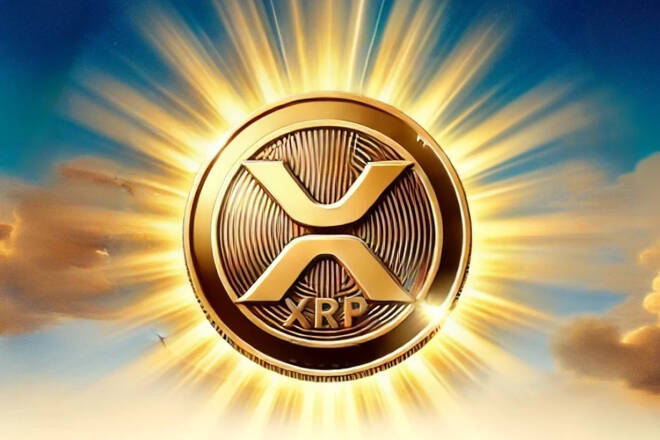Advertisement
Advertisement
XRP News Today: Bulls Eye $3.40 as Crypto Week Drives Momentum; BTC Hits New High
By:
Key Points:
- The SEC's July 17 closed meeting may include a vote to drop its Ripple appeal, possibly ending the XRP case.
- Ripple dropped its cross-appeal, pushing XRP to $2.9727; an SEC withdrawal could drive new highs.
- XRP extended its six-day rally, closing at $2.8353 on July 13 and outperforming the broader crypto market.
SEC vs. Ripple Case: Will This Be the Week the Case Ends?
On Thursday, July 17, the SEC will hold its third closed meeting since Judge Analisa Torres rejected Ripple and the SEC’s joint motion for an indicative ruling on settlement terms. The closed meeting could provide SEC Chair Paul Atkins and the Commissioners the opportunity to vote on dropping its appeal in the Ripple case.
The SEC and Ripple had previously agreed to drop their appeals if Judge Torres granted a favorable indicative ruling on settlement terms. These included lifting the injunction prohibiting XRP sales to institutional investors and reducing the $125 million penalty to $50 million.
Notably, Ripple announced it would drop its cross-appeal despite Judge Torres rejecting the settlement terms. If the SEC was willing to withdraw its appeal based on a ruling benefitting Ripple, the agency is unlikely to vote against dropping the appeal without the settlement.
XRP has soared from $2.0692 to a July 11 high of $2.9727 since Ripple announced dropping its cross-appeal. Despite the breakout, the token remains well below its 2018 all-time high of $3.5505 and 2025 high of $3.3999. An official announcement from the SEC that it’s withdrawing the appeal could be the catalyst for XRP to hit new highs.
Crypto Week: CLARITY Act in the Spotlight
While the SEC vs. Ripple case remains the key driver for XRP, legislative developments have also boosted sentiment. On Wednesday, July 9, Ripple CEO Brad Garlinghouse delivered testimony at a Senate Banking Committee’s hearing titled ‘From Wall Street to Web3: Building Tomorrow’s Digital Asset Markets.’ He used the platform to highlight the court rulings from the Ripple case.
Arguing for lawmakers to swiftly pass the Digital Asset Market Clarity (CLARITY) Act, Garlinghouse commented:
“And so, my concern in depending upon an unelected appointee to make those decisions is that it assumes a good faith actor. And I think, what we saw in the most recent SEC was just a war against the industry at large without a consistent application of that law.”
The CLARITY Act aims to create a regulatory framework for digital assets, including clarifying the roles of the SEC and CFTC in regulating the markets. Notably, the bill also prohibits exchanges from commingling customer assets with their own, aimed at preventing another FTX.
This week is Crypto Week. There will be House votes on the GENIUS Act, the CLARITY Act, and the Anti-CBDC Surveillance State Act. The SEC may also release its framework for the submission of crypto-spot ETFs, potentially expediting the approval of XRP-spot ETFs. An end to the Ripple case and XRP-spot ETF launches could see the XRP flip ETH for the #2 ranking by market cap.
XRP Price Outlook: Crypto Week, the SEC Appeal Vote, and ETF News
XRP rallied 3.56% on Sunday, July 13, adding to Saturday’s 0.20% gain and closing at $2.8353. The token outperformed the broader crypto market, which rose 1.52%, lifting the total market cap to $3.67 trillion.
XRP’s near-term price outlook depends on the SEC’s appeal vote, the progress of crypto bills, and US XRP-spot ETF headlines.
A breakout above the July 11 high of $2.9727 could enable the bulls to target the 2025 high of $3.3999. A sustained move above $3.3999 may bring the 2018 all-time high of $3.5505 into play.
Conversely, a drop below $2.50 could open the door to retesting $2.40, potentially exposing the 50-day Exponential Moving Average (EMA).
Explore our full XRP forecast here for key breakout zones and timing insights.
Bitcoin Hits New Record Highs as Spot ETF Inflows Soar
While XRP enjoyed a six-day winning streak, bitcoin (BTC) struck a new all-time high of $118,999 (Binance Exchange) in early trading on July 14. There are several key drivers behind BTC’s latest bull run, including:
- Legislative developments: A US regulatory framework could boost BTC adoption and pave the way for lawmakers to pass the Bitcoin Act.
- US BTC-spot ETF inflows: Total net inflows reached $2.718 billion in the week ending July 11, extending the weekly inflow streak to five weeks.
- Fed Monetary Policy: The chances of a September Fed rate cut stands at 64.6%, down marginally from 68.1% on July 3.
BTC Price Outlook: Legislation and Spot ETF Flows in Focus
BTC advanced 1.72% on July 13, reversing Saturday’s 0.23% loss to close at $118,625.
The near-term price outlook hinges on several key factors. These include legislative votes, the Fed’s policy stance, and spot ETF flow trends.
Potential scenarios:
- Bearish Scenario: Legislation roadblocks, hawkish Fed signals, and ETF outflows. A combination of these may drag BTC toward $110,000, exposing the 50-day Exponential Moving Average (EMA).
- Bullish Scenario: Bipartisan support for crypto bills, dovish Fed cues, and ETF inflows. Under these scenarios, BTC could target $120,000.
What to Watch
Investors should closely monitor the key drivers, which may determine if XRP and BTC can hit new record highs. These include:
- Ripple case updates: SEC appeal plans.
- Legislative developments: Hearings and lawmaker votes.
- Fed guidance: Hawkish or dovish guidance.
- ETF market flows: Flow trends crucial for BTC’s supply-demand balance.
See where analysts expect XRP and BTC to head as legal and political risks evolve.
About the Author
Bob Masonauthor
With over 28 years of experience in the financial industry, Bob has worked with various global rating agencies and multinational banks. Currently he is covering currencies, commodities, alternative asset classes and global equities, focusing mostly on European and Asian markets.
Advertisement
